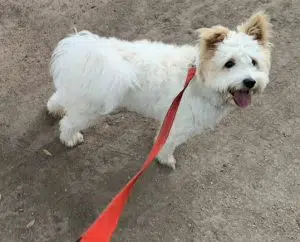
If you have ever wondered about exercising puppies and how much exercise your puppy needs, you are not alone.
Many new puppy owners can be confused about how little or how much exercise is right for their puppy, and whether it is a good or bad thing to get them running about as much as possible during the day, in the hope of a peaceful night’s sleep.
It is very important to keep in mind when exercising puppies is that their bones and joints are still growing and developing, so intense or prolonged exercise can lead to injuries and long-term health problems – so it should be avoided.
Dogs of all ages should be exercised twice a day. For puppies the time spent exercising should match their age.
A good rule of thumb is to stick to 5 minutes of exercise twice a day for each month of age. So a 3-month-old puppies would exercise for 15 minutes twice a day and then 20 minutes twice a day at 4 months and so on.
While our puppies have a lot of extra energy they need to burn off, and we certainly do need to keep their brains and bodies active, over-exercising puppies can damage their developing bones and joints.
This can lead to many common joint injuries and other issues including arthritis, knee, elbow and hip displaysia, while excessive exercise can also harm a puppy’s growth plates, cartilage tissue, and developing skeletal system.
Your puppy’s breed will also influence their exercise needs, as large breed puppies need even more consideration when it comes to protecting their bones and joints.
They also have different dietary considerations and grow at a different rate to smaller breed puppies, so it is important that you talk to your vet about your puppy’s specific needs.
In general though, the American Kennel Club suggests a common rule of five minutes of exercise per month of age, up to twice a day. For example, if your puppy is three months old, the you can exercise him or her for 15 minutes up to twice a day. Follow this rule until your puppy is fully grown. Once your dog is fully developed, they can exercise longer.
Walking is a great low-impact exercise option for puppies, and it can also provide an opportunity for socialization and mental stimulation.
Avoid taking your puppy for long walks or runs on concrete paths and roads for the first 12 months of their life, longer for those larger breeds.
Short play sessions with toys or other dogs can also be a fun way to burn off excess energy.
As we also want to make sure our puppies are socialised as much as possible during their critical period of development, exposing them to as many new environments, where they can play and interact with other dogs, people and objects as much as possible, will provide them with plenty of exercise as well.
Try taking your pup to the park or beach, where the grass and sand are softer on their joints.
Of course, be aware of the need to keep them safe as well, as some older dogs can be impatient and even become aggressive to little puppies that are still learning the rules of dog interactions.
Read my tips HERE on keeping your puppy or any dog safe at dog parks and beaches, and also ensure they have their vaccinations, before taking them to busy dog areas.
Starting positive reinforcement obedience training with your puppy as soon as you get them home is a great way to not only teach them the basics, but it also helps to build your relationship.
Puppies are super motivated by food, so using treats in this way is going to help accelerate their learning but remember not to use too many and keep them small – treats should not make up more than 10% of a dog’s total calorie intake.
Treats specifically formulated for puppies can be especially useful, so check out the Vitapet treat range.
While it is important we take our puppies outside the home and into new environments as much as possible for their socialisation, there are of course many ways for exercising puppies at home as well.
It is just as important to exercise their brains too, to help develop their cognitive ability and problem solving skills .
Games of tug and fetch get their bodies moving, while interactive toys, puzzles and snuffle mats provide both physical and mental stimulation as does obedience training, teaching them fun tricks and playing brain games with them. This type of environmental enrichment can help keep boredom and anxiety when left along at bay.
Some dog breeds require a lot more exercise than others, so make sure you do your research on the exercise needs of a breed you are considering and ensure you are able to meet their needs to help avoid many common dog behaviour problems.
The exercise needs of high-energy working dog breeds like the Border Collie is going to differ to that of a lap dog like the King Charles Cavalier Spaniel for example.
It’s also important to take breaks and allow your puppy to rest and drink water as needed on your walks.
Overheating can be a serious risk for puppies as can walking on hot pavements with bare paws so be extra mindful on warmer days and try to exercise in the early morning or late evening when the weather is cooler. This is something we should be doing for all dogs.
If you have just brought home, or are considering getting a puppy, then do make sure you check out more of my puppy-related articles HERE to help.
About the Author: Lara Shannon is a certified dog behaviourist and trainer, pet food nutrition specialist, Executive Producer and Host of Pooches at Play on Channel 10 and editor of Poochesatplay.com. Lara also runs her own dog training business in Melbourne’s Bayside area and is the Author of World of Dogs and Eat, Play, Love Your Dog

The role of moisture in dog food


Walking a dog – how much and why

Tips for exercising a dog indoors

Carbohydrates in dog food – what you need to know


Get your paws on Lara Shannon’s best selling books ‘Eat, Play, Love (your dog) and World of Dogs.
Available in Australia, USA, UK and Canada.